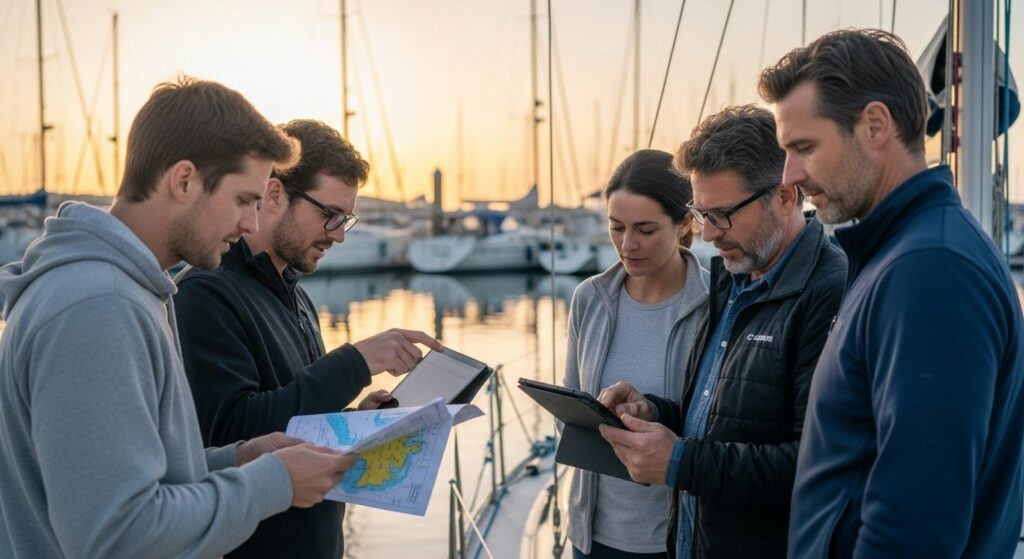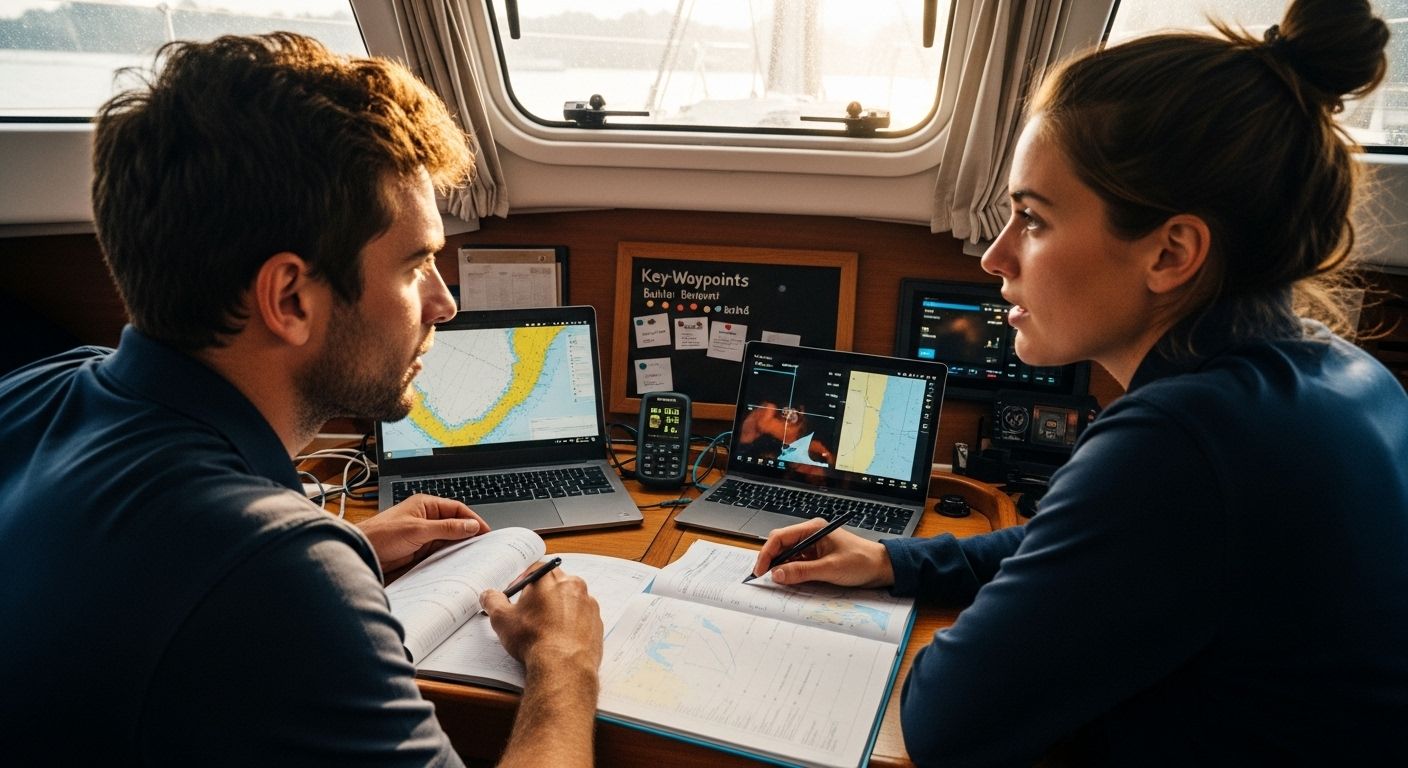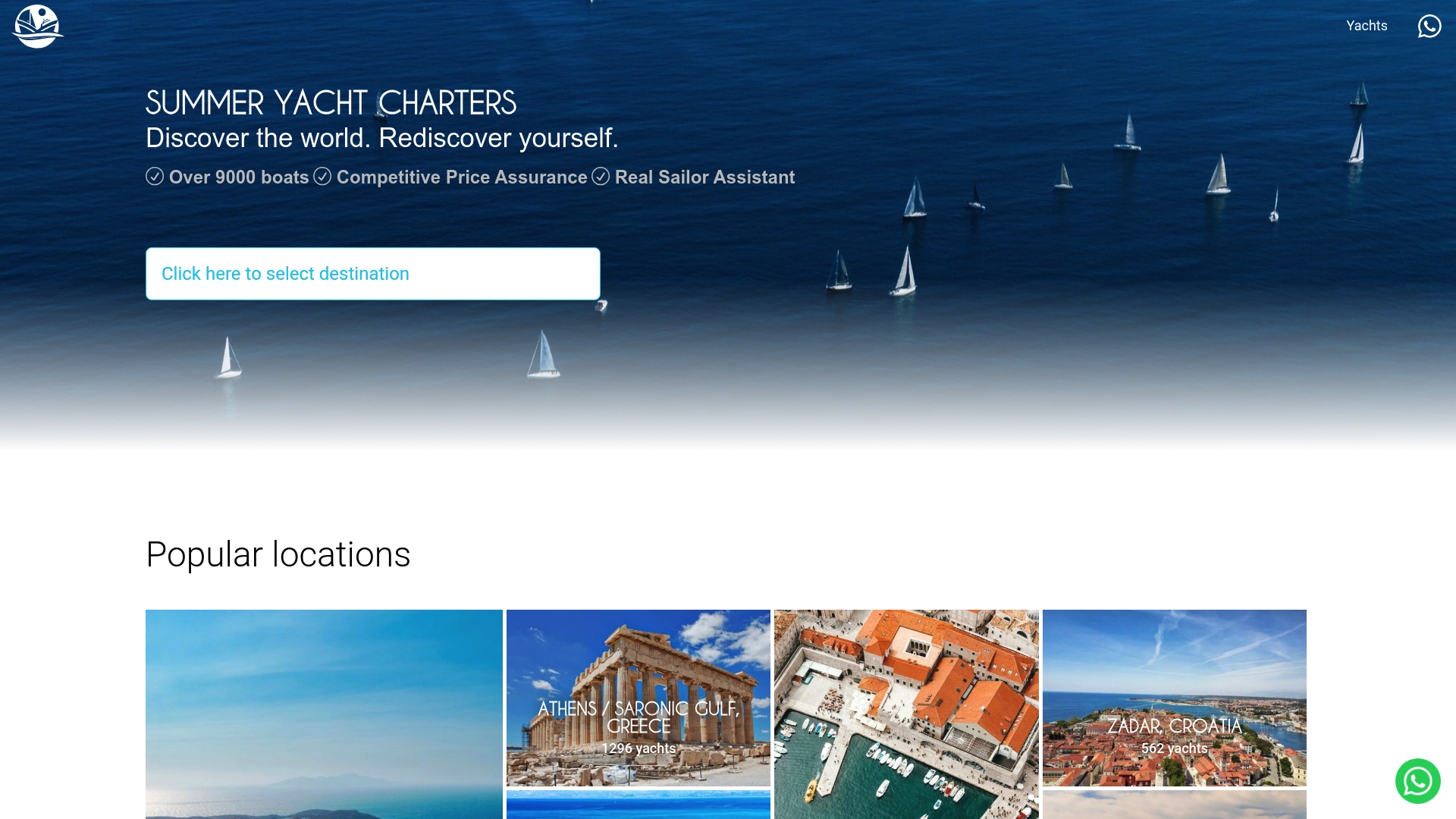How to Plan a Sailing Route: Expert Steps for Success
Discover how to plan a sailing route for every crew and journey. Learn proven steps for safer, smarter adventures on the water with confidence.

Planning a sailing route can look simple on paper and yet the difference between a smooth adventure and a stressful ordeal often comes down to the finer details. Most assume it is just picking a destination and setting sail, but research shows that effective sailing demands clear communication, teamwork, and the integration of both digital and traditional navigation tools. The real art lies not in plotting the shortest path but in balancing crew skills, strategic waypoints, and ever-changing sea conditions for an experience that stands apart from the ordinary.
Table of Contents
- Understanding Your Crew And Sailing Goals
- Choosing Destinations And Key Waypoints
- Weather, Navigation, And Safety Essentials
- Tools, Apps, And Resources For Route Planning
Quick Summary
| Takeaway | Explanation |
|---|---|
| Understand crew skills and goals | Assess each crew member’s competencies to ensure effective teamwork and clear sailing objectives. |
| Choose strategic waypoints carefully | Plan destinations and stopping points that optimize safety, resource management, and exploration opportunities. |
| Monitor weather continuously | Use multiple sources to track weather changes and adjust plans accordingly for safety. |
| Utilize digital navigation tools | Leverage modern software and apps for efficient route mapping and real-time tracking. |
| Combine digital and traditional resources | Integrate various tools and publications for comprehensive navigation strategies and informed decision-making. |
Understanding Your Crew and Sailing Goals
Successful sailing routes begin long before you chart a course on a nautical map. They start with a comprehensive understanding of your crew’s capabilities, expectations, and collective sailing objectives. Discover the essentials of yacht charter preparation to ensure a seamless maritime experience.
Assessing Crew Competencies and Experience
Before plotting any route, conduct a thorough evaluation of your crew’s sailing skills and experience levels. According to research on maritime teamwork, effective sailing demands clear communication, trust, and collective coordination. This assessment should include:
To help you thoroughly evaluate your crew before ploting your route, the following table summarises key crew competency areas and what you should consider for each one.
| Crew Competency Area | What to Assess |
|---|---|
| Technical Skills | Certifications, previous experience, maritime skills |
| Physical Capabilities | Fitness levels, health conditions |
| Navigation Knowledge | Familiarity with charts, GPS, navigation techniques |
| Communication Ability | Clear verbal/written communication, teamwork experience |
| Role Adaptability | Openness to assigned duties, flexibility in responsibilities |
- Technical Skills: Determine each crew member’s sailing certifications, previous sailing experience, and specific maritime competencies.
- Physical Capabilities: Consider the physical fitness and health conditions of all crew members.
- Navigation Knowledge: Evaluate individual understanding of nautical charts, GPS systems, and navigation techniques.
Defining Shared Sailing Objectives
Establishing a unified vision is crucial for a successful voyage. As international maritime planning guidelines emphasize, passage planning requires consensus and alignment among crew members. This involves:
- Discussing individual expectations for the journey
- Identifying collective goals (recreational exploration, skill development, competitive sailing)
- Establishing clear roles and responsibilities for each crew member
Importantly, these objectives must balance safety considerations with adventure. Under the SOLAS V regulations, comprehensive passage planning is not just recommended but legally mandated. This includes meticulously appraising crew abilities and ensuring safety protocols are understood and implemented by all team members.
By investing time in understanding your crew’s dynamics, skills, and shared aspirations, you create a solid foundation for a memorable and successful sailing expedition. Remember, a well-prepared crew is your most valuable navigation tool.
Choosing Destinations and Key Waypoints
Selecting the right destinations and strategic waypoints transforms a routine sailing trip into an extraordinary maritime adventure. Learn more about planning your perfect sailing itinerary to maximize your journey’s potential and enjoyment.
Strategic Route Planning Considerations
Route selection demands a meticulous approach that balances multiple critical factors. According to NOAA marine navigation guidelines, sailors must comprehensively evaluate several key elements when determining destinations and waypoints:
- Navigational Safety: Assess potential maritime hazards, including underwater topography, current patterns, and potential weather challenges.
- Distance and Sailing Conditions: Calculate realistic daily travel distances based on your vessel’s capabilities and crew’s sailing experience.
- Fuel and Resource Management: Plan waypoints that allow strategic resupply and potential shelter if unexpected conditions emerge.
Identifying Optimal Waypoints and Stopping Points
Successful maritime routes are not linear paths but carefully choreographed sequences of strategic stopping points. Effective waypoint selection involves:
- Identifying natural harbours and marine protected areas
- Considering anchor-friendly locations with appropriate depth and protection
- Evaluating potential emergency diversion points
- Mapping locations that offer interesting maritime experiences or cultural exploration
Professional sailors understand that waypoints are more than geographical markers. They represent opportunities for rest, resupply, exploration, and potential adventure. Each waypoint should be chosen with precision, considering factors like local maritime regulations, potential berthing facilities, and proximity to essential services.

By approaching destination and waypoint selection as a comprehensive strategic exercise, you transform your sailing journey from a simple transit into a dynamic, adaptable maritime experience. Remember that flexibility remains key research, prepare thoroughly, but remain open to adjusting your plan as conditions and opportunities present themselves.
Weather, Navigation, and Safety Essentials
Navigating the open waters requires a comprehensive understanding of weather patterns, precise navigation techniques, and robust safety protocols. Explore essential sailing safety preparations to ensure a secure and enjoyable maritime journey.
Advanced Weather Monitoring and Interpretation
Weather represents the most dynamic and potentially challenging element of any sailing expedition. According to the National Weather Service marine safety guidelines, successful sailors must develop sophisticated weather monitoring skills. This involves:
- Continuous Forecast Analysis: Utilize multiple sources including marine radio, satellite communications, and professional meteorological services
- Understanding Marine Weather Patterns: Recognize specific indicators of changing conditions such as wind shifts, cloud formations, and barometric pressure changes
- Real-time Weather Tracking: Implement advanced digital tools and mobile applications for immediate weather updates
Navigation Techniques and Modern Technologies
Modern sailing navigation transcends traditional chart reading. The BoatUS Foundation’s Marine Navigation course highlights the importance of integrating multiple navigation technologies and techniques:
- Mastering electronic navigation systems
- Understanding GPS and digital chartplotter functionalities
- Learning to cross-reference digital and traditional navigation methods
- Identifying and interpreting marine Aids to Navigation (ATONs)
Professional sailors recognize that navigation is both an art and a science. It requires continuous learning, adaptability, and a methodical approach to interpreting maritime environments.
Safety remains paramount in any maritime journey. The combination of advanced weather monitoring, precise navigation skills, and comprehensive safety protocols transforms potential challenges into manageable experiences. By investing time in training, understanding technological tools, and maintaining a vigilant approach, sailors can confidently navigate even the most unpredictable maritime conditions.
Remember that preparedness is your greatest asset. Continuous education, regular equipment checks, and a commitment to safety protocols will ensure that your sailing adventure remains both exciting and secure.
Tools, Apps, and Resources for Route Planning
Modern sailing route planning has been revolutionized by sophisticated digital tools and collaborative platforms that transform traditional navigation methods. Discover the latest navigation technologies for sailors to enhance your maritime journey’s precision and safety.
Digital Navigation and Charting Software
Navigational technologies have dramatically expanded sailors’ capabilities for route planning and real-time tracking. According to research on maritime navigation software, modern digital platforms offer comprehensive features for route mapping and vessel tracking. Key digital navigation tools include:
This table provides an overview of essential digital and traditional navigation tools and resources referenced in the article, highlighting their main features and applications for route planning.
| Navigation Tool/Resource | Type | Main Features/Applications |
|---|---|---|
| OpenCPN | Digital | Open-source chartplotter, route mapping, nav inputs |
| Electronic Chartplotters | Digital | Real-time positioning, integrated systems |
| Mobile Navigation Applications | Digital | Maritime navigation on smartphones |
| OpenSeaMap | Collaborative | Community-generated nautical charts, waypoint database |
| Sailing Directions | Traditional | Coastal navigation specifics, regulations, thorough guides |
- OpenCPN: An open-source maritime chart plotter supporting multiple chart formats and advanced navigation inputs
- Electronic Chartplotters: Integrated systems providing real-time positioning and route tracking
- Mobile Navigation Applications: Smartphone apps offering comprehensive maritime navigation capabilities
Collaborative Mapping and Information Resources
Collaborative platforms have transformed how sailors gather and share critical maritime information. The OpenSeaMap project exemplifies this trend by providing freely accessible worldwide nautical charts. Essential collaborative resources encompass:
- Community-generated maritime maps and waypoint databases
- Real-time weather and maritime condition updates
- Shared navigational hazard and port facility information
- User-generated route recommendations and sailing experiences
Professional Navigation Publications and References
While digital tools offer remarkable convenience, professional sailors continue to rely on authoritative printed and digital references. Sailing Directions publications remain crucial for comprehensive maritime planning, offering detailed insights into:
- Coastal navigation specifics
- Country-specific maritime regulations
- Detailed port and facility information
- Comprehensive navigational hazard assessments
Successful route planning emerges from a strategic blend of cutting-edge digital technologies and traditional maritime knowledge. By leveraging multiple resources, sailors can create robust, adaptable navigation strategies that balance technological innovation with time-tested maritime expertise.
Remember that no single tool or resource provides a complete solution. The most effective route planners integrate multiple information sources, maintain a flexible approach, and continuously update their knowledge and techniques.
Frequently Asked Questions
What are the key factors to consider when planning a sailing route?
When planning a sailing route, it is essential to consider crew competencies, safety measures, navigational hazards, distances, fuel management, and potential waypoints for resupply or shelter.
How can I assess my crew’s sailing skills before setting sail?
You can evaluate your crew’s sailing skills by assessing their technical skills, physical capabilities, navigation knowledge, communication ability, and adaptability to assigned roles, ensuring a well-prepared team.
Why is it important to monitor weather continuously while sailing?
Continuous weather monitoring is vital to ensure safety, as changing weather conditions can significantly affect sailing plans. Using reliable forecasts and real-time updates allows for timely adjustments to the route.
What digital tools can enhance my sailing route planning?
Digital tools like electronic chartplotters, mobile navigation applications, and open-source software such as OpenCPN provide features for route mapping and real-time tracking, enhancing navigation efficiency.
Turn Expert Route Planning into an Unforgettable Mediterranean Sailing Adventure
You have just discovered the key steps for plotting a safe, tailored sailing route, but transforming these expert strategies into reality can feel overwhelming. Whether you are concerned about matching itineraries to your crew’s skills or unsure how to handle dynamic weather and waypoint decisions, your dream voyage deserves seamless support and local expertise. Unlock a world of thoughtfully crafted sailing routes designed around practical safety, flexible navigation, and handpicked destinations across the Mediterranean.

Let Summer Yacht Charters turn your careful route planning into a stress-free, truly personalised charter. Secure your ideal yacht and build your perfect journey by visiting Summer Yacht Charters today. Begin now to ensure the best selection and start planning your next adventure with confidence.
Recommended
- Sailing Holidays for Couples: Discover Romantic Destinations – Summer Yacht Charters
- What to Wear Sailing: Clothing Guide for Every Sailor – Summer Yacht Charters
- How to Anchor a Yacht Safely: Step-by-Step Guide – Summer Yacht Charters
- Yachting with Friends: Top Experiences & Expert Tips 2025 – Summer Yacht Charters
- What Is a Travel Itinerary? Guide for U.S. Travelers – Yopki
- Ultimate Vacation Planning Checklist for 2025: US Travelers Guide – Yopki